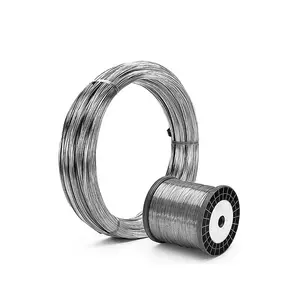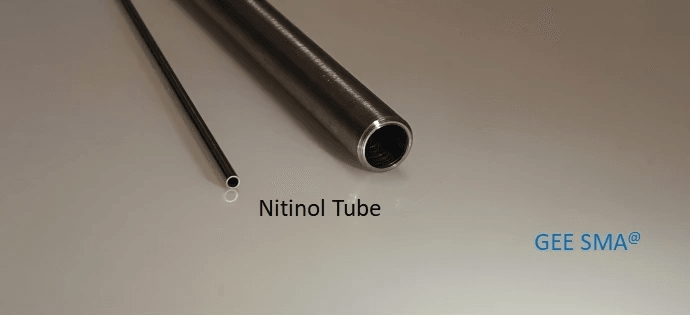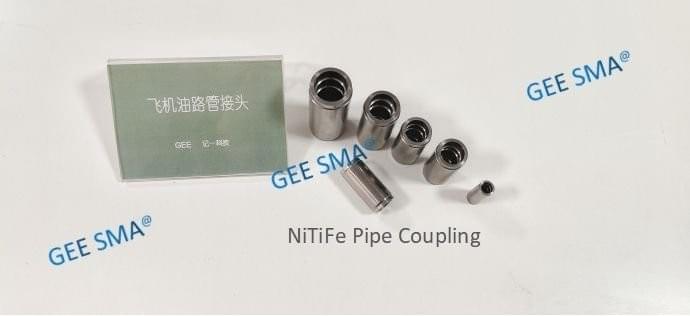Introduction

In the realm of advanced materials, few innovations have captured attention quite like nitinol wire. This remarkable alloy, composed primarily of nickel and titanium, exhibits unique properties that set it apart from traditional metals such as nickel wire. Understanding nitinol wire is essential for grasping its potential applications across various industries, making it a sought-after material often listed as nitinol wire for sale.
Understanding Nitinol Wire
Nitinol wire is a type of shape memory alloy (SMA) that can return to a predetermined shape when heated above a certain temperature. Unlike standard metals, nitinol exhibits both the shape memory effect and superelasticity, making it incredibly versatile in design and functionality. This dual capability has led to its widespread use in sectors ranging from medicine to aerospace.
The Science Behind Shape Memory Alloys
At the heart of nitinol's fascinating behavior lies the science of shape memory alloys. When deformed at lower temperatures, these materials can revert to their original configurations upon heating, thanks to their unique crystalline structure comprised of nitinol nickel titanium. This phenomenon not only provides intriguing possibilities but also highlights the advantages of using shape memory metals in practical applications.
Applications of Nitinol in Various Industries
The applications of nitinol are as diverse as they are impactful; this innovative material has revolutionized medical devices such as stents and guidewires due to its biocompatibility and flexibility. In aerospace engineering, nitinol flat wire is utilized for actuators and other components where weight savings are critical without sacrificing performance. Furthermore, automotive innovations harnessing nitinol wire promise enhanced safety features and improved efficiency, ensuring this remarkable alloy remains at the forefront of technological advancement.
What is Nitinol Wire

Nitinol wire is a fascinating material that combines the properties of nickel and titanium to create a unique type of shape memory alloy (SMA). This innovative wire can return to its original shape after being deformed, making it incredibly useful in various applications. Understanding what nitinol wire is, how it differs from traditional nickel wire, and the benefits of shape memory metals will provide insight into its growing popularity in modern technology.
Exploring the Composition of Nitinol
Nitinol is composed primarily of nickel and titanium, typically in a ratio of about 50:50. This specific combination gives nitinol its remarkable properties, including superelasticity and the ability to remember shapes when heated or cooled. The term niti refers to nickel and nol refers to titanium, highlighting its unique blend that sets it apart from more common materials like nickel wire.
The precise composition can vary slightly depending on the desired characteristics for specific applications. For instance, variations in the nickel-titanium ratio can influence the temperature at which nitinol transitions between its different states. This versatility makes nitinol flat wire ideal for precision engineering tasks where exact specifications are crucial.
How Nitinol Differs from Nickel Wire
While both nitinol and nickel wire share some similarities due to their primary component being nickel, they exhibit drastically different behaviors under stress and temperature changes. Nickel wire lacks the unique shape memory effect that defines nitinol; when bent or twisted, it does not revert back to a predetermined form like nitinol does. This fundamental difference makes nitinol far more valuable for applications requiring adaptability and resilience.
Additionally, unlike standard nickel wire which remains rigid under pressure, nitinol can undergo significant deformation while still returning to its original shape once conditions change. This characteristic allows engineers to use nitinol in ways that would be impossible with traditional materials like nickel or steel wires. As a result, industries are increasingly seeking out nitinol wire for sale as they recognize its superior performance capabilities.
The Benefits of Shape Memory Metals
Shape memory metals such as nitinol offer several advantages over conventional materials that make them highly sought after across various sectors. One major benefit is their ability to respond dynamically to changes in temperature; this allows them to be used effectively in applications ranging from medical devices to robotics where movement is essential. With features like superelasticity and fatigue resistance, these alloys provide durability without sacrificing performance.
Furthermore, using shape memory metals can lead to long-term cost-effectiveness due to reduced maintenance needs and increased lifespan compared with traditional materials such as copper or steel wires. Their lightweight nature also contributes significantly towards enhancing efficiency across numerous industries—from aerospace innovations utilizing lightweight components made from nitinol flat wire to automotive designs aimed at reducing overall vehicle weight for better fuel economy.
In summary, investing in materials like nitinol provides access not only to cutting-edge technology but also opens doors for creative solutions across diverse fields—making it an attractive option worth considering whenever you come across “nitinol wire for sale.”
The Mechanics of Nitinol

Nitinol, a remarkable alloy of nickel and titanium, operates on fascinating principles that make it a standout among shape memory metals. Its unique properties allow it to return to a predetermined shape when heated, making it invaluable in various applications. In this section, we will delve into the mechanics that underpin nitinol wire's extraordinary capabilities.
Shape Memory Effect Explained
The shape memory effect is one of the most captivating features of nitinol wire. When subjected to specific temperatures, this alloy can remember its original shape after being deformed; a process that occurs due to its unique crystalline structure. Essentially, when you bend or twist nitinol wire into a new form and then heat it above its transformation temperature, it springs back to its predefined shape—making it an essential material in industries ranging from medical devices to robotics.
This property sets nitinol apart from traditional nickel wire and other materials that lack such adaptability. The ability to revert to an original form not only enhances functionality but also ensures reliability in critical applications like stents and guidewires in medical settings. With the rising demand for innovative solutions, it's no wonder that many are searching for nitinol wire for sale.
Superelasticity in Action
Superelasticity is another fascinating characteristic of nitinol nickel titanium alloys that allows them to undergo significant deformation without permanent change. Unlike conventional materials, which might break under stress, superelastic nitinol can stretch up to eight times its original length and return without any lasting damage once the stress is removed. This remarkable flexibility makes nitinol flat wire ideal for applications where resilience and durability are paramount.
In practical terms, superelasticity means that components made from nitinol can endure harsh conditions while maintaining their performance integrity—perfect for aerospace or automotive innovations where reliability is non-negotiable. Engineers often leverage this property when designing products that must withstand extreme forces or environmental conditions without failing—a feature not commonly found in standard nickel wire or other alloys.
How Nitinol Wire Responds to Temperature
Temperature plays a pivotal role in how nitinol wire behaves; it's almost like the alloy has a personality! When cooled below its transformation temperature, the material becomes pliable and can be shaped easily—ideal for manufacturing processes or custom applications requiring intricate designs with precision like those found in surgical instruments or aerospace components. Conversely, upon heating above this threshold, it regains its rigid structure and remembers its original configuration.
This thermal responsiveness is what makes nitinol so versatile as both a functional component and an innovative solution across various sectors—from medical devices needing precise movement control to automotive parts requiring robust performance under fluctuating temperatures. As industries continue exploring advanced materials like shape memory metals, the demand for high-quality options such as nitinol wire will undoubtedly grow.
Practical Applications of Nitinol Wire

Nitinol wire is not just a scientific curiosity; it has practical applications that span multiple industries, showcasing its versatility and unique properties. From medical devices to aerospace technologies, the shape memory alloy's ability to return to a predetermined shape after deformation makes it an invaluable resource. Let's dive into some of the most exciting uses of nitinol wire and see why it's in such high demand.
Medical Devices and Implants
In the medical field, nitinol wire is revolutionizing how we think about devices and implants. Its biocompatibility and flexibility make it ideal for stents, guidewires, and orthopedic implants that adapt to the body's movements while maintaining structural integrity. With nitinol nickel titanium alloys, surgeons can perform minimally invasive procedures more effectively, leading to quicker recovery times for patients.
Moreover, the shape memory effect allows these devices to expand or contract within the body at specific temperatures, enhancing their functionality. This means fewer complications during surgeries and improved patient outcomes overall. If you're in the market for innovative medical solutions, keep an eye out for nitinol wire for sale; it's changing lives one implant at a time!
Aerospace Uses of Nitinol
The aerospace industry thrives on innovation and efficiency—two qualities that nitinol wire embodies perfectly. Engineers are utilizing this remarkable material in actuators and couplings where weight savings are critical without compromising performance or safety. Nitinol's superelasticity provides aircraft components with enhanced durability under extreme conditions, making it a go-to choice for modern aviation technology.
Additionally, nitinol flat wire is being explored as a potential solution in deployable structures like satellite antennas or solar panels that need to withstand harsh space environments while remaining lightweight. The ability to revert back to its original shape after deformation can lead to designs that save space during launch but expand once in orbit—an ingenious application! As more aerospace companies recognize its benefits, expect an uptick in demand for various forms of nitinol wire.
Automotive Innovations Using Nitinol
Automotive engineers are also tapping into the potential of nitinol wire for enhancing vehicle performance and safety features. By integrating this shape memory metal into components like active suspension systems or self-healing materials, manufacturers can create cars that respond dynamically to road conditions while improving ride comfort. This means smoother drives ahead—who wouldn’t want that?
Moreover, with growing environmental concerns driving innovation in electric vehicles (EVs), using lightweight materials like nitinol helps increase efficiency by reducing overall vehicle weight without sacrificing strength or resilience compared to traditional nickel wire options. As automotive technology continues evolving toward sustainability goals, expect more exciting developments involving nitinol wires hitting the market soon!
The Advantages of Using Nitinol Wire

Nitinol wire, a unique alloy of nickel and titanium, boasts several advantages that make it a preferred choice across various industries. Its precision and functionality are unparalleled, especially in applications where exact movements are crucial. Additionally, nitinol wire's durability in harsh conditions sets it apart from traditional materials like nickel wire, ensuring longevity and reliability even in extreme environments.
Precision and Functionality
When it comes to precision, nitinol wire shines as a standout performer among shape memory metals. Its ability to return to a predetermined shape when heated allows for incredibly accurate mechanical functions that are essential in fields like medicine and robotics. Whether it's used in stents or actuators, the precision offered by nitinol wire ensures that devices operate flawlessly under varying temperatures.
Moreover, the functionality of nitinol flat wire is enhanced by its superelastic properties, which allow it to undergo significant deformation while still returning to its original form. This makes it an ideal candidate for applications requiring flexibility without compromising strength or accuracy. With nitinol wire for sale from various suppliers, businesses can easily access this innovative material to meet their specific needs.
Durability in Harsh Conditions
Nitinol's resilience is one of its most compelling advantages over traditional materials such as nickel wire. It exhibits remarkable resistance to corrosion and fatigue, making it suitable for use in challenging environments such as medical implants or aerospace components. Unlike standard metals that may degrade over time, nitinol maintains its structural integrity even under extreme conditions.
This durability extends the lifespan of products made from nitinol wire significantly compared to those made from other materials like nickel-based alloys. In industries where equipment failure can lead to catastrophic results, using nitinol wires ensures peace of mind knowing that components will withstand tough operational demands without faltering. As more manufacturers recognize these benefits, the demand for high-quality nitinol wire continues to rise.
Long-term Cost-effectiveness
Investing in nitinol wire may seem daunting initially due to higher material costs compared with conventional options like nickel wires; however, the long-term cost-effectiveness cannot be overlooked. The longevity and reduced maintenance needs associated with products made from shape memory alloys mean fewer replacements and repairs over time—ultimately saving money for businesses in the long run.
Additionally, the efficiency provided by nitinol's unique properties often leads to improved performance outcomes across various applications—from medical devices that require precise movements to automotive innovations demanding reliable functionality under stress conditions. As companies increasingly seek out reliable solutions with minimal downtime or replacement costs, investing in quality nitinol flat wire becomes an economically sound decision.
In conclusion, whether you're looking at precision engineering or durability against harsh elements, choosing nitinol will undoubtedly enhance your projects' overall effectiveness while proving cost-efficient over time—making it a wise investment indeed!
GEE SMA: Leading Nitinol Production

When it comes to the world of nitinol production, GEE SMA stands out as a leading manufacturer, known for its commitment to quality and innovation. Their expertise in producing high-quality nitinol wire ensures that customers receive reliable and effective shape memory alloys for various applications. Whether you’re looking for nitinol flat wire or other forms, GEE SMA has you covered with materials that meet stringent industry standards.
High-Quality Nitinol Materials
GEE SMA prides itself on crafting high-quality nitinol materials that are essential in numerous fields, including medical devices and aerospace engineering. The combination of nickel and titanium in their nitinol wire offers exceptional performance characteristics such as superelasticity and the shape memory effect, making it a preferred choice over standard nickel wire. By utilizing advanced manufacturing techniques, they ensure that each batch of nitinol nickel titanium is consistent, reliable, and ready to meet the demands of modern technology.
Custom Solutions for Unique Needs
Understanding that one size doesn’t fit all, GEE SMA provides custom solutions tailored to unique customer requirements. Whether it's specific dimensions or specialized properties of shape memory metals required for a particular application, their team works closely with clients to deliver exactly what they need. This flexibility not only enhances the functionality of their products but also opens up new possibilities for innovative uses of nitinol wire across various industries.
Nitinol’s Role in Space Missions
Nitinol’s remarkable properties have made it an invaluable asset in space missions where reliability is crucial under extreme conditions. GEE SMA supplies specialized nitinol components designed specifically for aerospace applications; these include actuators and couplings that can withstand significant temperature fluctuations while maintaining performance integrity. As space exploration advances, the demand for robust materials like nitinol wire continues to grow—making GEE SMA a key player in this exciting frontier.
Conclusion
As we wrap up our exploration of nitinol wire, it's clear that this remarkable shape memory alloy holds immense potential for the future of technology. With its unique properties and versatility, nitinol wire is poised to revolutionize various industries, from medical devices to aerospace applications. As research and innovation continue to expand, we can expect even more groundbreaking uses for this extraordinary material.
The Future of Nitinol in Technology
The future of nitinol in technology is bright and brimming with possibilities. Researchers are continuously discovering new applications for nitinol nickel titanium, particularly in fields like robotics and soft actuators where flexibility and strength are paramount. As advancements in manufacturing techniques improve the quality and availability of nitinol wire, we can anticipate a surge in innovative products that leverage the exceptional properties of shape memory metals.
Why Nitinol Wire is Worth Investing In
Investing in nitinol wire is not just a smart move; it’s a forward-thinking decision that aligns with the trends shaping modern industries. The durability and reliability of nitinol flat wire make it an ideal choice for demanding applications where traditional nickel wire might falter under pressure or temperature fluctuations. Moreover, as more industries recognize the benefits of shape memory alloys, the demand for high-quality nitinol wire will only increase, making it a valuable asset for manufacturers and investors alike.
Finding Nitinol Wire for Sale Today
If you’re eager to harness the benefits of this revolutionary material, finding nitinol wire for sale has never been easier! Numerous suppliers offer a range of options including standard sizes as well as custom solutions tailored to your specific needs—whether you're looking for thin strands or robust flat wires. By exploring reputable sources online or connecting with specialized distributors, you can secure high-quality nitinol materials that will elevate your projects to new heights.

